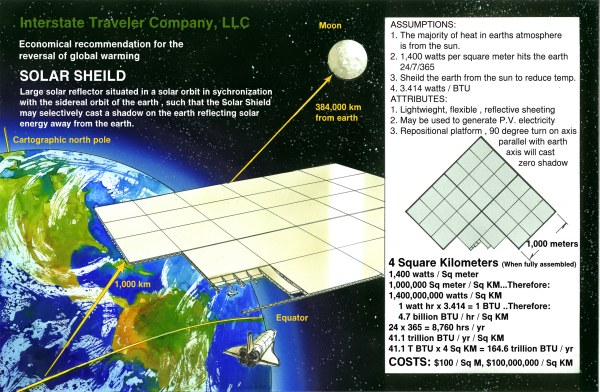Interstate Traveler Company's
Solar Shield
Upon the consideration of global warming in the basic sense of thermal energy
transfer, the impartial analyst must determine the greatest source of thermal
energy that affects the Earth's atmosphere; which is the sun. As a
student of Geology and Geophysical research, I have looked as most of the
prevailing wisdom regarding global warming and the incredible danger posed by
the melting of just the Greenland Ice Sheet the solution came to mind that the
best way to battle global warming would be to cut back on some of the sun's
relentless rays.

In this basic example, it is shown that a simple and relatively inexpensive
solar shield or solar 'reflector' can be placed in sidereal orbit reflecting
away a measurable amount of the sun's rays. By reflecting the rays
away before they hit the Earth's atmosphere, massive amounts of thermal energy
can be reflected away to help reduce the effects of Global Warming.
As shown in the inserted illustration, a 4 square kilometer area has the ability
to reflect away a potential 164.6 Trillion BTUs / year. Also, by
positioning the solar shield at approximately 65 degrees North Latitude to
provide a 4 square kilometer shade from the noontime sun for a few minutes to
help stem the melting of glaciers.
To put 164.6 Trillion BTUs / year into perspective you can consider the rough
equivalent 234,874 domestic 80,000 BTU/hr furnace equivalent running 24 hours a
day 365 days a year. Therefore, the Space Shield can protect the Earth's
atmosphere from that tremendous amount of energy.
164.6 Trillion BTU per year divided by 8760 hours per year is 18,789,954,337
BTUs per Hour. Divide again by 80,000 to arrive at 234,874 furnace
equivalents.
Certainly if the system was built to harvest the solar power it would generate a
valuable byproduct beside helping to cool the Earth and shade the glaciers from
the noon time sun. For the purposes of this analysis only the reflective
capacity of extremely inexpensive materials is under consideration to achieve
the highest amount of energy reflected away at the lowest possible costs.
 click thumbnail image for full resolution.
click thumbnail image for full resolution.
As a student of Geophysical studies, I found it quite easy to locate a multitude
of sources that determine the total surface area of the global ocean then use
the surface area plugged into an Excel spread sheet as a basis for a volume of
water required to increase the level of the ocean by a variable amount.
I then found multiple sources for the estimated volume of the Greenland Glacier
and calculated the volume of water contained in the Greenland ice sheet with a
significant reduction from the known estimates. I then performed a
mathematical conversion of the volume of water in the Greenland ice sheet and
came up with a global ocean rise in excess of ten feet. I ran the numbers
again and again, and it is optimistic to think the global ocean will only rise
10 feet when it could be more. You can examine the attached Excel sheet
and see how I put the numbers together. The spread sheet itself could be
organized a little better, but it still calculates the numbers.
A BTU is defined as the amount of heat required to raise the temperature of one
pound
of water by one
degree
Fahrenheit. Melting a pound of ice at 32 °F requires 143 BTU.
164.6 Trillion BTUs is enough to raise 164.6 trillion pounds of water one
degree.
Ocean Surface Area
Calculator.xls
Draft-Press Release – The End of Global Warming
Space Shield Analysis
|